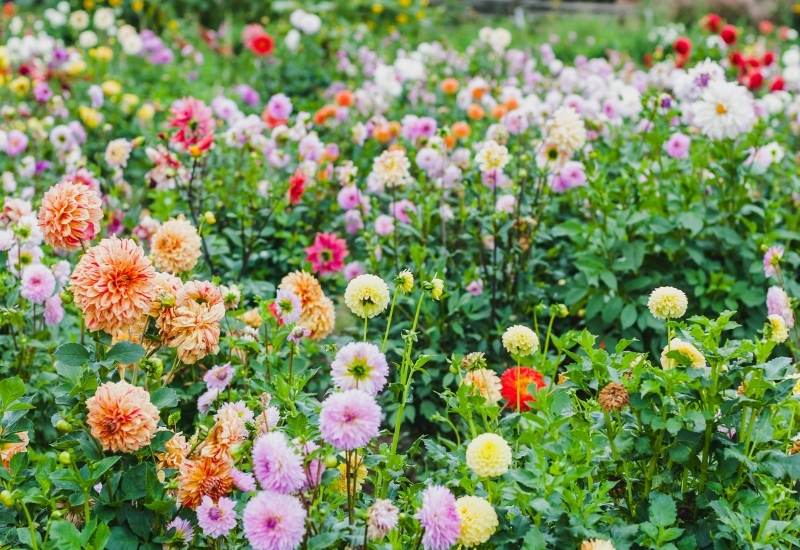
Dahlias, the national flowers of Mexico, look amazing in borders and beds with their round, sometimes huge flowers, that can reach a foot in diameter (30 cm)! They fill late summer and fall with the most amazing colors, often in warm shades like flaming red and hot orange…
They are generous with their blooms, easy to grow and they fan bring to your garden that Central American experience it so much needs as the days get shorter… But did you know that there are many types of dahlias?
Dahlias have been cultivated in Europe since 1787. In this time, botanists and growers have developed many different cultivars and varieties of dahlias, including the very popular double pompon shaped ones.
The main types of dahlia flowers are in fact classified as decorative dahlias, pompon and ball dahlias, cactus and semi cactus dahlias, anemone and collarette dahlias, mignon dahlias, single dahlias, peony and orchid dahlias and finally waterlily dahlias.
With over 57,000 varieties, dahlias come in a dizzying array flower colors, shape, size and booming time, so choosing your favorite can be confusing.
To help you to recognize the different varieties and pick the most appropriate for your garden, we have composed a list of the most popular different types dahlias and how to identify them by flower type.
Why There Are Many Types Of Dahlia?
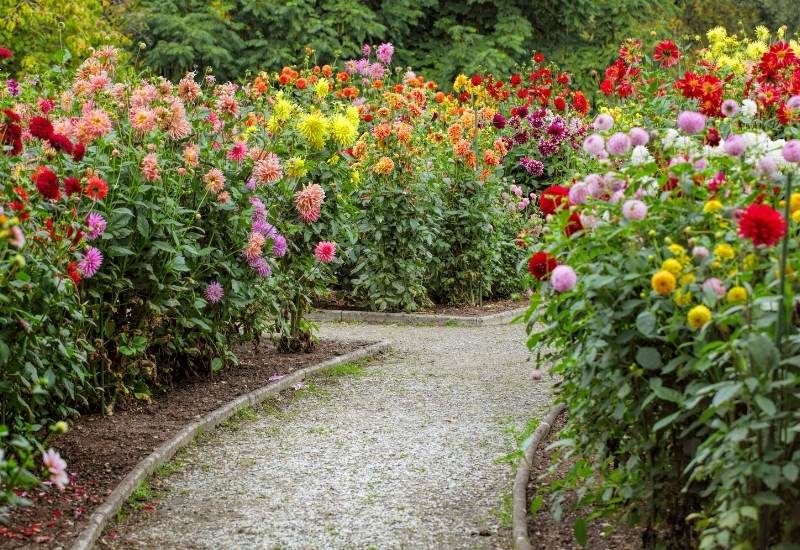
Think about a dahlia…Done? Was it a big round pompon flower? Or maybe it had a thinner concave shaped but pointed petals, but still lots of them?
Well, you wouldn’t find any dahlia like that growing spontaneous in South America… Why? Most dahlias we grow in our gardens are cultivars.
Let me wind back a few centuries and explain…
Dahlias were known even to the Aztec and other pre-Columbian populations, but when the Spanish came to America, the flower caught the attention of Francisco Hernàndez, King Philip II’s physician… It was 1570!
About two centuries later, Antonio José Cavanilles, the director of the Royal Gardens of Madrid, first managed to grow a dahlia through vegetative reproduction in Europe.
From then on, we have hybridized them, selected them, bred new cultivars… There are now so many varieties that no one has yet counted them.
The thing is that botanists discovered that it was easy to get the florets in the disk (like those of daisies and sunflowers, to which dahlias are related) to grow a long petal, like for ray flowers.
And so, double and semi-double dahlias came along, and with them, many other types of dahlias.
And no… double flowered dahlias are not natural…
Dahlia Varieties Grouped By Flower Characteristics
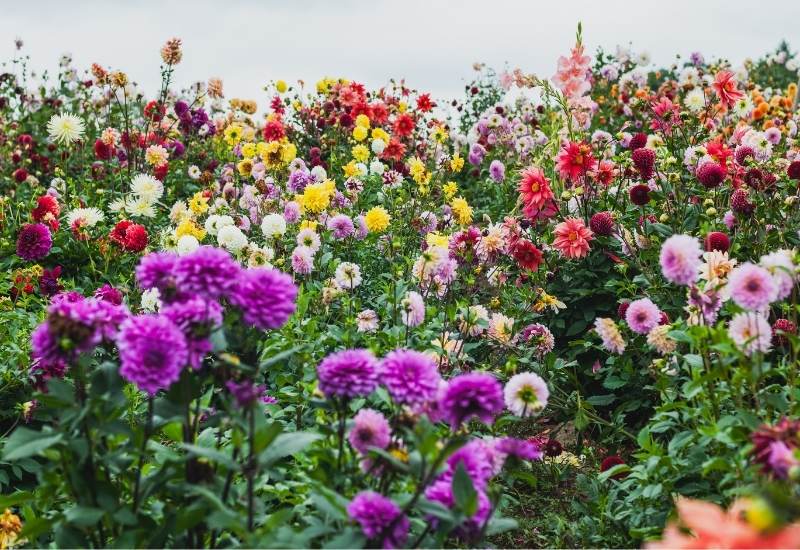
Here we go then, with so many varieties, it is easy to get lost… So gardeners have taken a leaf out of botanists and grouped them into 8 main groups.
What mainly determines which of these groups a dahlia belongs to is the shape of the flower.
Natural dahlias have only eight petals, but then double flowers came along, and these had different petal shapes and arrangements…
But the size of the plant may vary too according to the category it belongs to.
Mignon and single dahlias tend to be shorter than decorative dahlias, for example…
So, here are the 8 categories most gardeners use to distinguish dahlias:
Types of Dahlia Flower Form Classes
And now it is time to learn how to tell them apart. We’ll look at each category in turn and then we’ll also see a few examples you can pick for your garden.
Here’s the list of the different dahlia groups, along with some classification info and few examples of a variety in each group.
Decorative Dahlias
Decorative dahlias are some of the most well known and well loved varieties in the world. They are actually a large group, which has two key characteristics:
Apart from this they range in color and size. They offer all colors in the range of white to deep purple (via yellow, pink, orange and red) and some are small and compact (down to 15 inches max., which is 38 cm) so very good for containers flower beds, but others are giants an they can grow up to an impressive 7 feet tall (more than 2 meters!), and more appropriate to large borders.
The flowers too range from a few inches across to massive blooms that can reach a whole foot in diameter (30 cm)!
Within this category then there are two subcategories:
So, here are 4 for you to look at, just to give you a practical idea of what they are all about.
1. Decorative Dahlia ‘April Dawn’ (Dahlia ‘Arabian Night’)
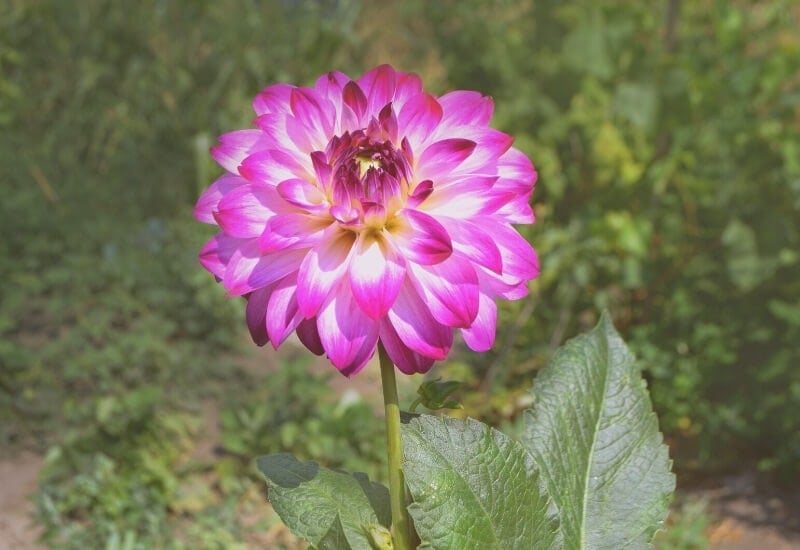
Here is a vigorous bloomer with elegant and showy, bright flowers that bring both light and a romantic touch to your garden from mid summer all the way to the first frost.
In fact, ‘April Dawn’s flowers catch the light of the Sun in their center, where they are of the brightest yellow shade ever.
Then, as we move towards the tips, the petals become white, adding a “halo of light” to the already luminous center. The whole is crowned with vivid magenta pink tips!
The flowers are abundant and large too, as they can reach 8 inches across (20 cm). This makes it a great plant to lift the mood and energy of any large border, though you can also grow it in containers.
2. Decorative Dahlia ‘Eveline’ (Dahlia ‘Eveline’)
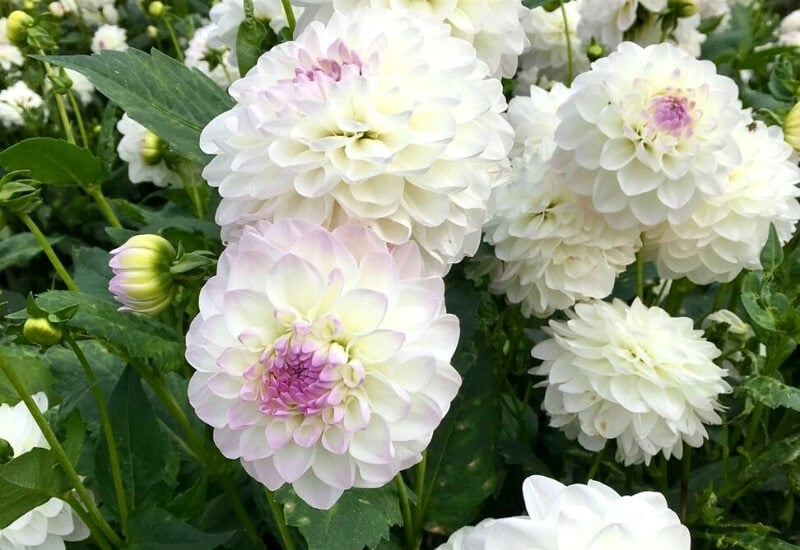
For a stunning white variety with very thick blooms, almost to the point of resembling a pompon dahlia, ‘Eveline’ is a perfect example.
Its flowers are round and white; the petals are curled at the center but flatten at the tips, which have a dash of pastel but bright lavender to them.
Because of this, ‘Eveline’ is a perfect flower even in formal settings; the delicate shading of this flower highlights the regularity and plasticity of the petals.
It will look amazing in large containers in a terrace or patio, but you can also choose to mix it into borders and tall beds.
3. Decorative Dahlia ‘Arabian Night’ (Dahlia ‘Arabian Night’)
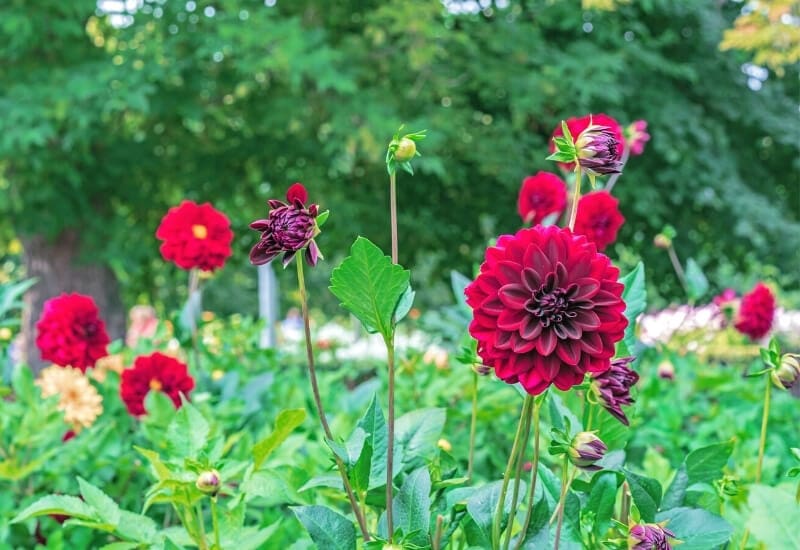
If dahlias are known for their warm, even autumnal colors, ‘Arabian Night’ proves the point. Its deep red flowers have velvety petals, which adds to the sensuous appearance of this amazing double flower. They also have very regular petals; it is a formal decorative dahlia.
Having said this, ‘Arabian Night’ may look great as a centerpiece in a beautiful pot on a sun-bathed terrace, but if you plant it with other flowers in a border or flower bed, it will add depth of passion but also of color and texture.
4. Decorative Dahlia ‘Mystery Day’ (Dahlia ‘Mystery Day’)
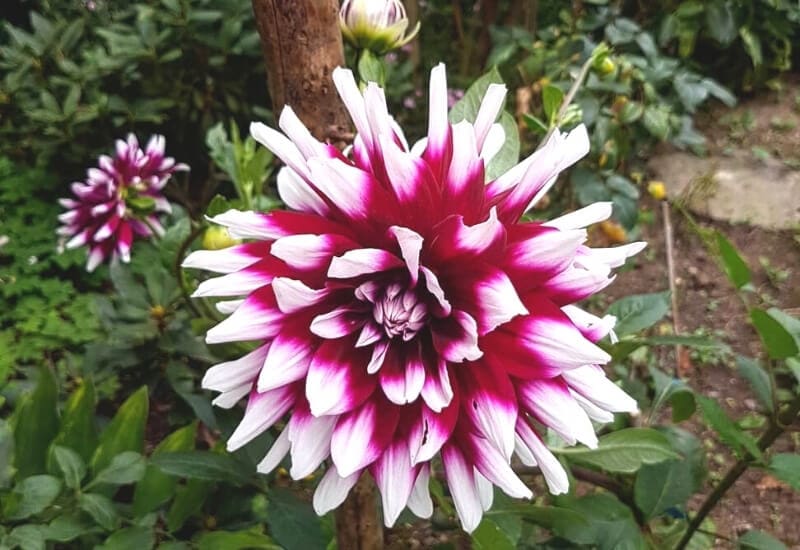
With decorative dahlia ‘Mystery Day’ you can bring all the energy and passion of Central America to your garden, terrace or patio!
Yes, because it has large flowers with broad but pointed petals, and they are deep garnet red with snow white tips! The contrast is so energetic! And when I say large, I mean 8 inches across (20 cm)!
This is one of the showiest dahlias ever, so you can use it as an eye catching protagonist on your patio or terrace, or also in flower beds and borders, maybe surrounded by less striking flowers.
2: Pompon And Ball Dahlias
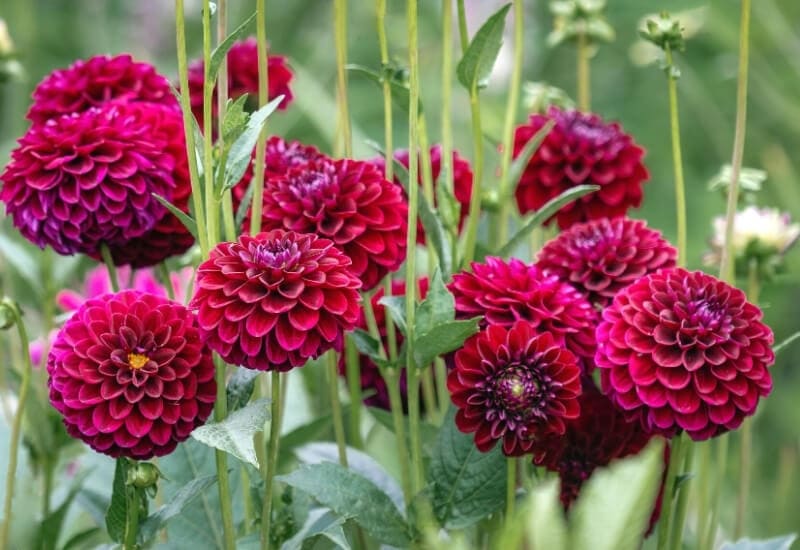
Pompon and ball dahlias are as iconic as declarative dahlias. They are very easy to recognize because the have very striking features…
For these reasons, pompon and ball dahlias have excellent architectural qualities. You can use them to add interesting shapes and depth to your beds and borders, for example.
What is more, because of their geometrically perfect blooms, they look great in formal gardens as well, even in a modern looking urban gravel garden, a brightly colored pompon dahlia would not be out of place…
They too come in a huge range of colors along the white to purple gradient. They also have different sizes: they range from 12 inches tall (30 cm) to 6 feet (180 cm).
Pompon dahlias however have different sizes: pompon dahlias are about 2 inches across (5 cm), while ball dahlias have flowers that reach 1 foot across (30 cm). To be exact. Ball dahlias also have a slightly flattened ball at the center, but this is being picky…
So, ready to meet a few?
1. Ball Dahlia ‘Jowey Winnie’ (Dahlia ‘Jowey Winnie’)
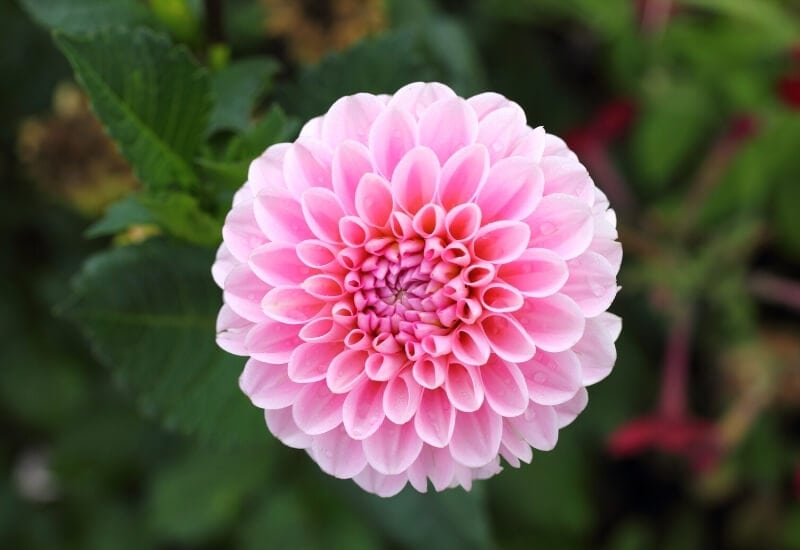
For a classical ball dahlia look, the salmon pink ‘Jowey Winnie’ can hardy have rivals. And you can add the very romantic and soft coloring of its beautifully and regularly arranged petals to the ensemble to get a perfect balance between elegance and feelings.
The flowers are about 4 inches across (10 cm) and they look amazing even in formal settings… Just imagine a pastel colored gravel garden (maybe on the orange range) and these beautiful pink spheres growing from decorative pots!
Of course you can also use it to give an architectural dimension to a romantic border or flower bed.
2. Ball Dahlia ‘Meghan Dean’ (Dahlia ‘Meghan Dean’)
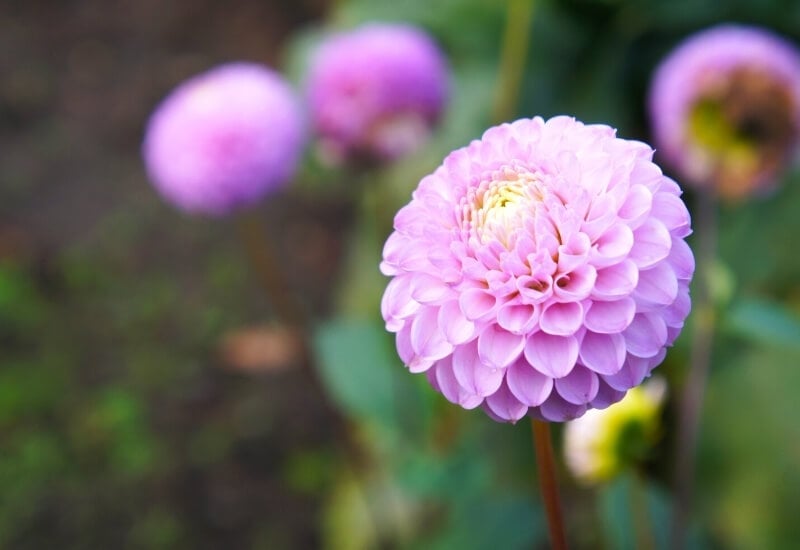
With longer petals than ‘Jowey Winnie’, ball dahlia ‘Meghann Dean’ may not have the same compact effect. Still its more relaxed and extended petals, coupled with its beautiful bright lavender pink shade make it a very attractive flower indeed.
They too can reach about 4 inches across (10 cm) and while they look less “full” and sculptural, they reflect the light better.
This is an excellent variety you can use in less informal settings, like beds, borders or pot compositions that want both showy flowers and a natural, old world appearance. It mixes well with romantic palettes (with pinks) as well as with whites or purples.
3. Ball Dahlia ‘Marble Ball’ (Dahlia ‘Marble Ball’)
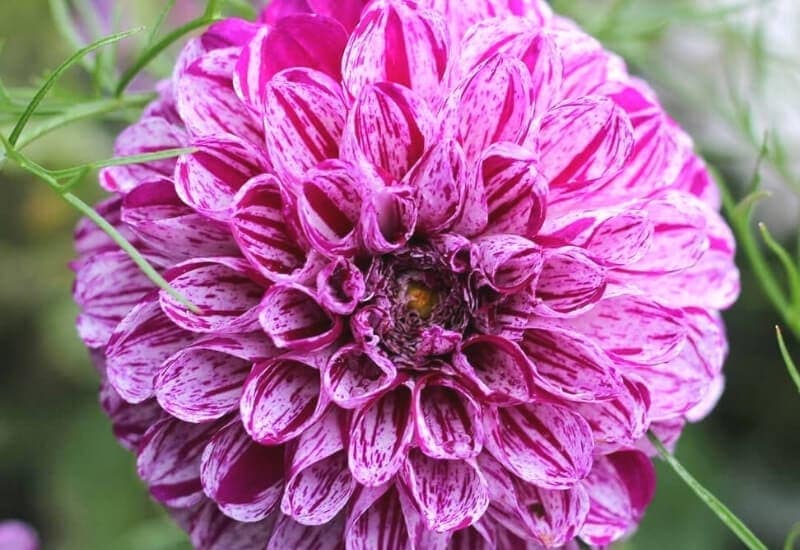
Exquisitely decorative, ‘Marble Ball’ has some unique features that set it apart from other ball and pompon dahlias. Namely, the coloring and the shape of the petals.
The flowers, which are fairly small (4 inches, or 10 cm across) are in fact variegated. It is hard to achieve a good effect with double colors and very regular shapes, but this cultivar does it perfectly.
They are, in fact, purple with white dashes in it, giving it the effect of a marble sculptures. The petals also bend slightly backwards at the tips. This makes it a very dynamic flower indeed.
This is a flower that wants to be looked at and will obtain what it wants. It is excellent in city and courtyard gardens, especially in a very prominent position. Alternatively, mix it in with other flowers in beds and borders for a playful effect.
4. Pompon Dahlia ‘Franz Kafka’ (Dahlia ‘Franz Kafka’)
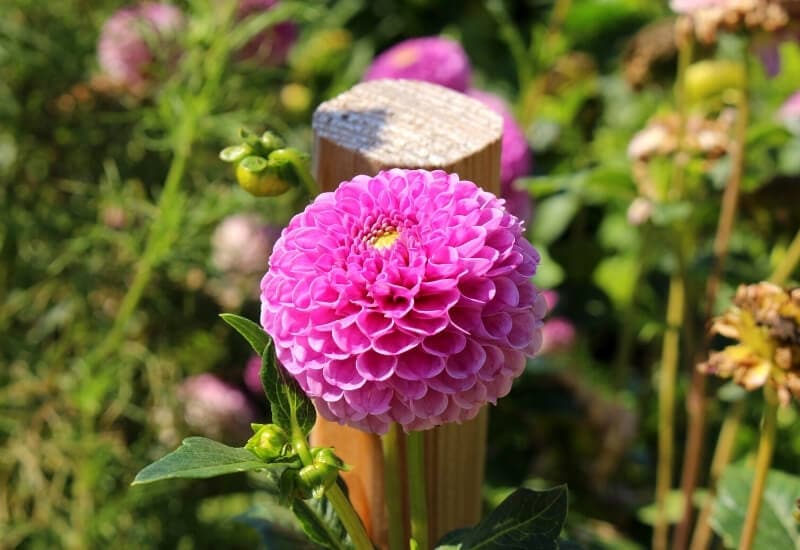
Pompon dahlias look better in groups… Because the have smaller flowers than ball dahlias, you will be looking for a “collective effect”, rather than the striking isolated plant. And an all time favorite by gardeners is ‘Franz Kafka’.
It is fairly short and the flowers are not too big, about 2 to 3 inch across (5 to 7.5 cm), but they are perfectly spherical and very abundant.
The color is usually bright magenta pink, but it often changes along the bloom, starting with off white pink and then becoming richer and richer.
This adds variety of color within a flower bed or border, with a very reliable flower that will start in summer and will not stop giving till the very first frost.
3: Cactus And Semi-Cactus Dahlias
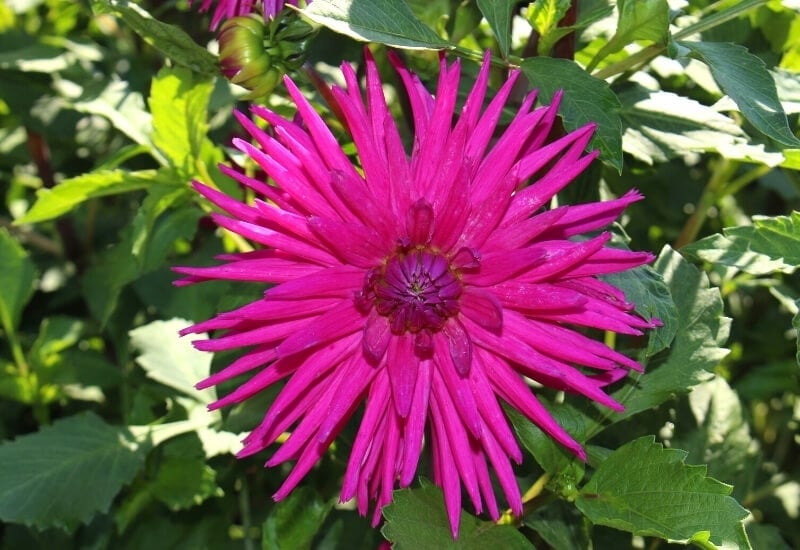
Cactus and semi-semi cactus are the most dramatic of all dahlias. They have been developed to look full of pathos and intensity. This is because of the shape of their flowers, which is also what sets them apart from other flowers of the same genus.
The size of the plants and flowers can vary a lot. They can be small, as low as 12 inches (30 cm) or quite tall, up to 6 feet (180 cm). The smaller varieties are ideal for dramatic window boxes. The flowers themselves go from 2 inches across (5 cm) to 1 foot (30 cm)!
They are available in the usual wide range of colors of dahlias and they are ideal to bring a sense of emotional turmoil, wild passion and strong feelings to your garden.
Just have a look at a few to see what I mean…
1. Semi-Cactus Dahlia ‘Bridge View Aloha’ (Dahlia ‘Bridge View Aloha’)
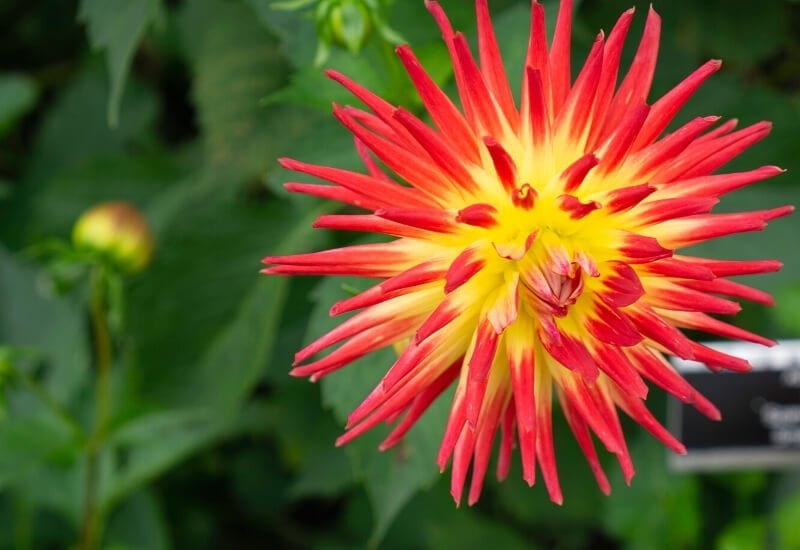
You can hardly get more strikingly dramatic than semi-cactus dahlia ‘Bridge View Aloha’…. It has a rosette of pointed petals that can take your breath away.
In fact, they are of the brightest and most lively yellow in the center of the flower but turn bright flaming red towards the tips.
And they are big! They can reach 8 inches in diameter (20 cm). Enough said…
This is a flower you cannot hide… You can use it to make your garden the most colorful and vivid place in the neighborhood from July all the way to the first frost. Surely a bold statement, this flower can turn your garden into fireworks.
2. Cactus Dahlia ‘Dutch Explosion’ (Dahlia ‘Dutch Explosion’)
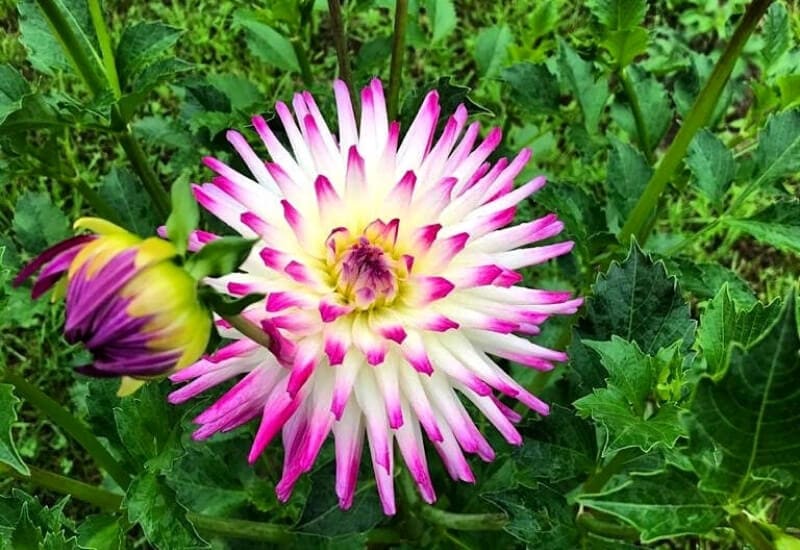
This flower is actually shocking. It is so bold and bright that you will need sunglasses to look at cactus dahlia ‘Dutch Explosion’!
Why? Its petals are snow white, actually whiter than white at the base, towards the center of the flower and of the strongest magenta color ever starting about halfway along its length to the tips.
The drama is enhanced by the curved tips, which curl up like little horns towards the end of the petal. The flowers are about 4 to 6 inches wide (10 to 15 cm).
This is again a flower you want to grow if you need a strong element of color, drama, architecture and energy in your garden. It does adapt well to modern and urban gardens too, especially on its own.
3. Semi-Cactus Dahlia ‘My Love’ (Dahlia ‘My Love’)
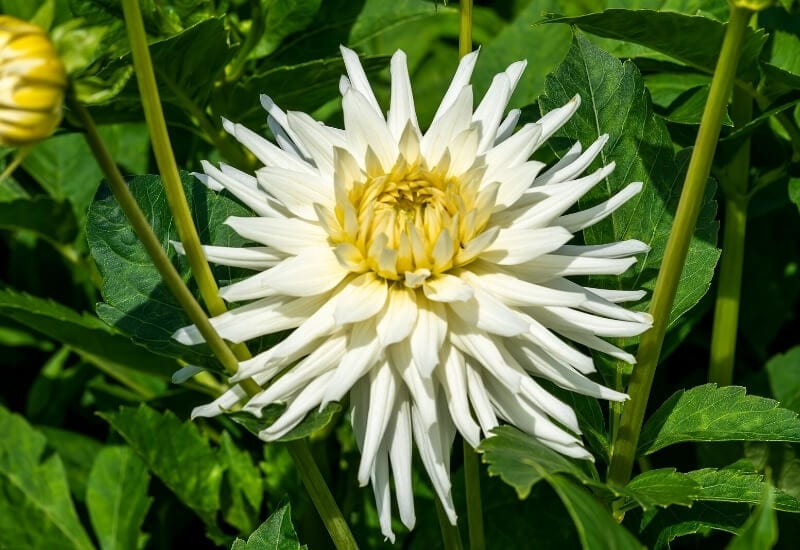
Semi-cactus dahlia ‘My Love’ has a different effect from the previous two.
Why? The genius of this plant is to combine the striking shape of the cactus and semi-cactus dahlias with the color white!
While the passionate and dramatic elements given by warm and strong colors disappear, we are left with an elegant and sculptural flower which foregrounds its shape and brightness.
The flowers are hard to muss, as they are 6 inches across (15 cm).
This is an excellent choice for a very elegant border or tall flower bed. It looks particularly beautiful against dark foliage.
4: Anemone And Collarette Dahlias
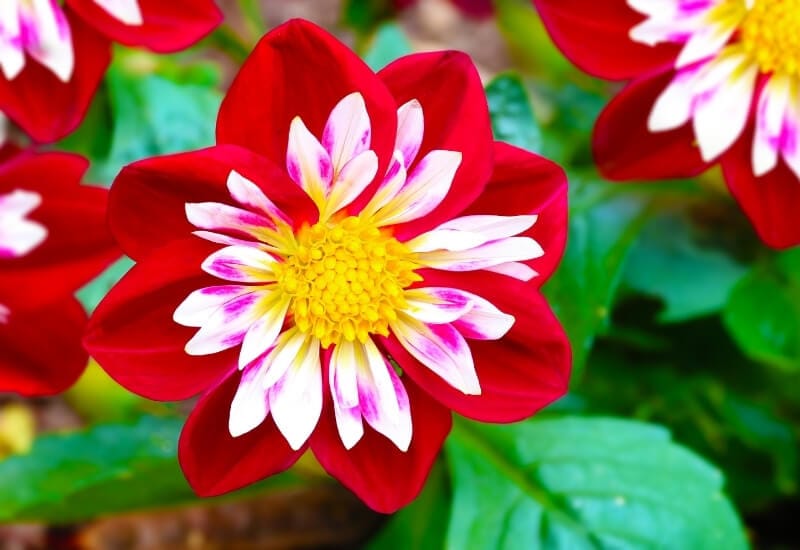
Anemone and collarette dahlias are less common than the varieties we have seen so far. They are strange, in fact, as they look a cross between a single flower and a double flower. And in fact they are just that.
While these dahlias are less common with amateurs, dahlia lovers really appreciate the sophistication of these flowers, which can add an elegant and delicate touch to flowers, beds and containers.
So, let’s see a couple to check out!
1. Collarette Dahlia ‘Night Butterfly’ (Dahlia ‘Night Butterfly’)
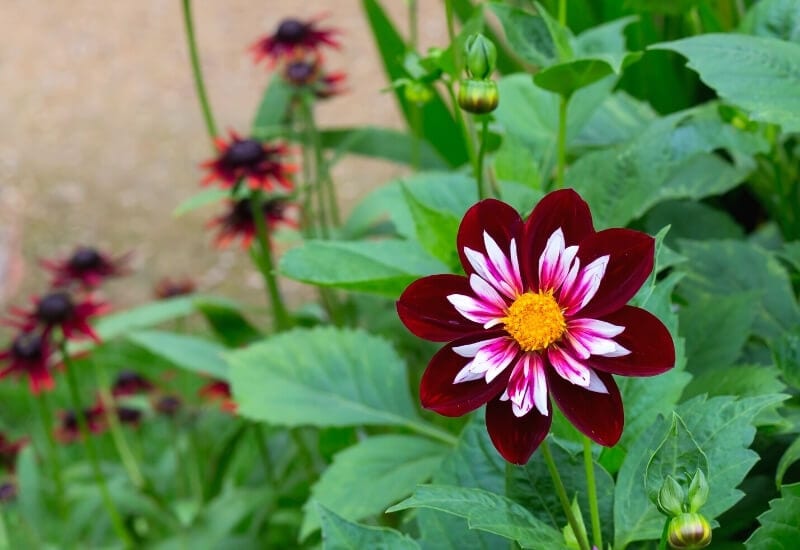
A great example of a collarette dahlia is ‘Night Butterfly’. It has all the right elements: the rich coloring, the shorter and different petals and the intriguing play of shapes and shades between the two.
The outer petals are velvety and of the deepest dark red you can imagine; the inner and shorter ones instead are white and purplish pink. All capped by a saffron yellow center disk!
You can see how this flower spells luxury and elegance but also passion, and how it could be a welcome addition to your borders or beds if this is the effect you are after.
2. Anemone Dahlia ‘Que Sera’ (Dahlia ‘Que Sera’)
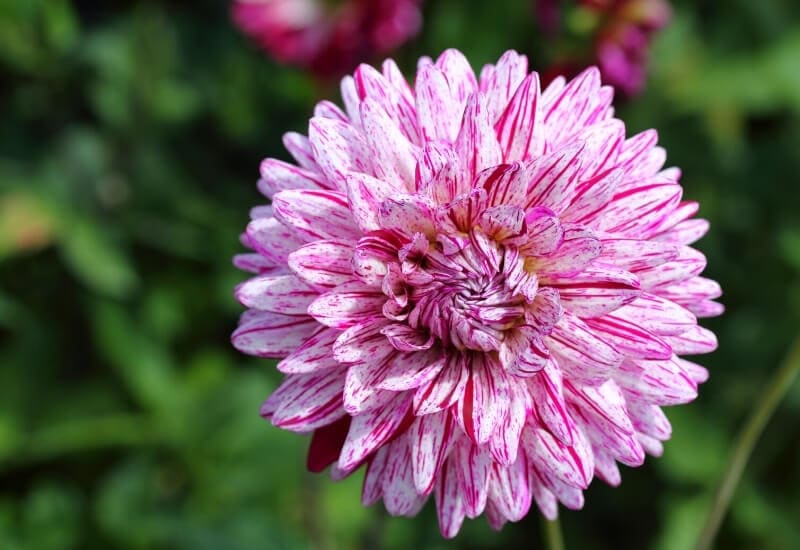
Anemone dahlia ‘Que Sera’ is a very sophisticated flower that will give you that “old English manor house” look, but it also looks perfect for bouquet… It has multiple outer petals that start off white and end up violet purple. The inner petals are white and purple too, but more on the magenta range.
The ensemble of these fairly large flowers (up to 6 inches wide, or 15 cm) is one of silky or lace-like complexity. It will look great in a cottage garden, but you can use it in most informal settings.
5: Mignon Dahlias
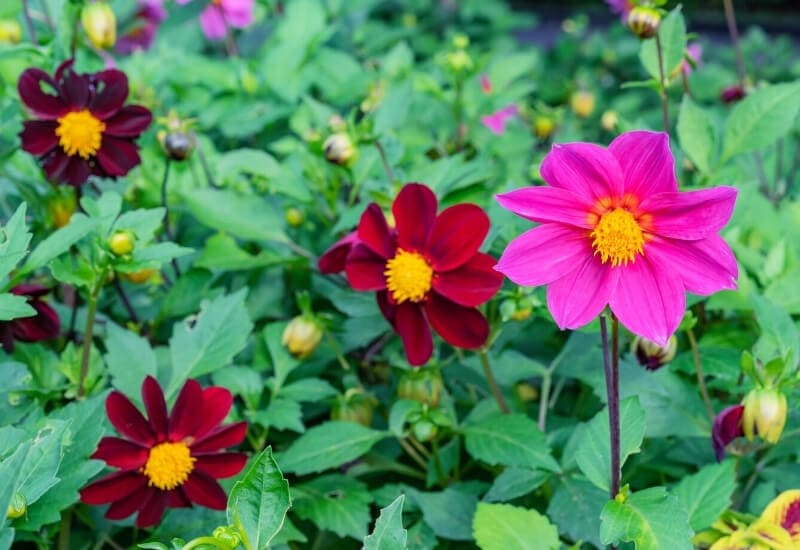
Dahlias don’t need to be always double flowers. In fact, the original types are relatives to daisies. Yes, they have a central disk with tubular florets in it and then ray flowers with one large petal each – like sunflowers…
Mignon and single dahlias retain this characteristic. But they are also different. We’ll see single dahlias next, but first , mignon…
These dahlias are less showy than the double varieties we have seen so far, but their presence in borders and beds is still of great value indeed, as they come in many colors and sizes and they are sweetly beautiful indeed.
And here are two to prove my point.
1. Mignon Dahlia ‘Scura’ (Dahlia ‘Scura’)
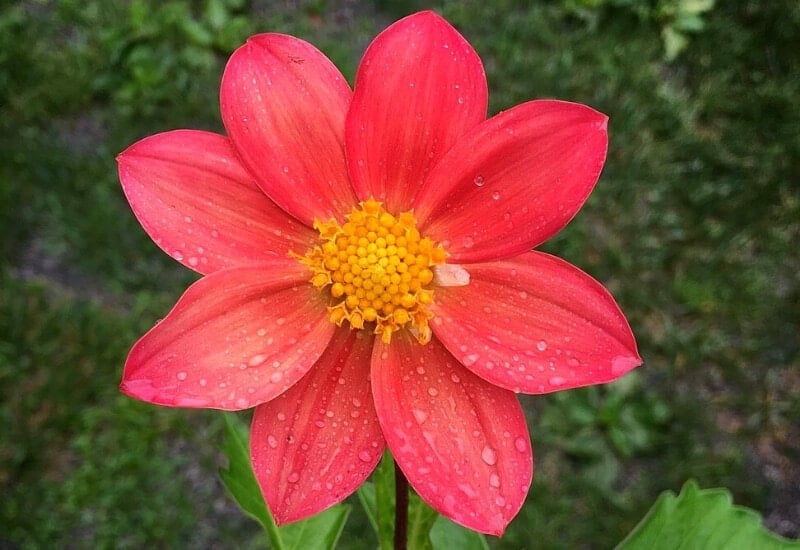
Mignon dahlia ‘Scura’ is a classical looking flower, but with the brightest vermillion red petals, round and broad with hinted dents at the tips. These are velvety in texture, and the color is then taken up in the central disk too.
These flowers are not large, only 1 inch wide (2.5 cm), but they look lovely against the dark green foliage, which turn purple like the stems of the plant.
They are excellent for low beds and borders, but also for containers and window boxes.
2. Mignon Dahlia ‘G.F. Hemerick’ (Dahlia ‘G.F. Hemerick’)
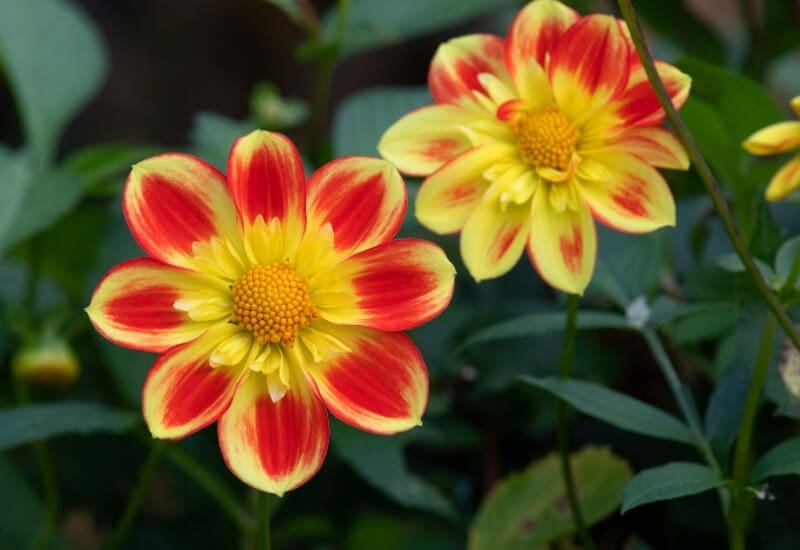
Mignon dahlia ‘G.F. Hemerick’ replaces the bold, striking and very showy look of traditional ball dahlias with a delicate and sophisticated array of colors and shapes.
This small cultivar, in fact, has 8 oval and pointed petals with deep straight grooves on them. This gives them a “paper flower” feeling, which, combined with its harmonious shape, may remind you of oriental flowers and flower arrangements.
All this delicacy is crowned with the most beautiful coral orange petals with a very bright but small golden disk in the middle.
It is short and the flowers are small, but they do not need size to tell your visitors that you are refined and sophisticated. They will crate a corner of delicate emotions in your beds and borders, with a dreamy and nostalgic elegant touch.
6: Single Dahlias
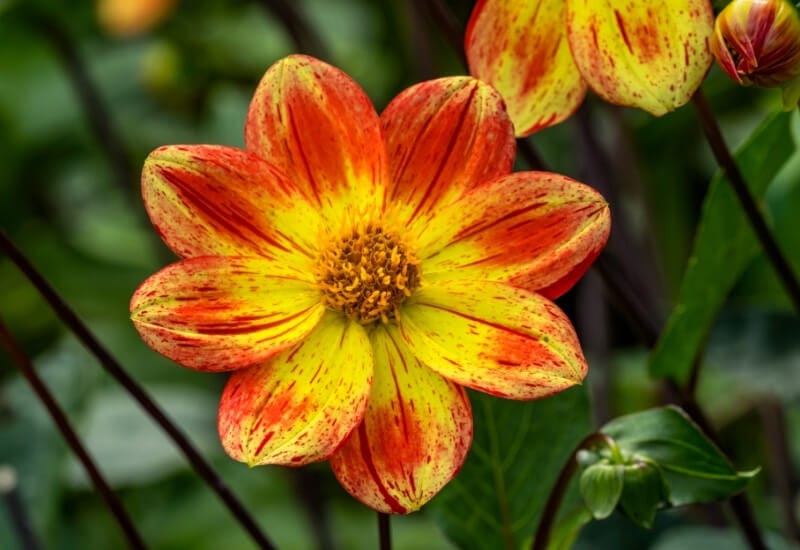
Few people think of single dahlias when they hear this flower mentioned. Yet this is what they look like in Nature! And single dahlias, while they miss the showy presence of double and semi/double ones, are very elegant and attractive.
They don’t look as exotic, but they still bring with them the sunny feeling of Mexico and neighboring areas, just with a more natural. And maybe simpler touch.
They are similar to mignon dahlias but…
And just to show you how beautiful they are, here are two for you.
1. Single Dahlia ‘Sunshine’ (Dahlia ‘Sunshine’)
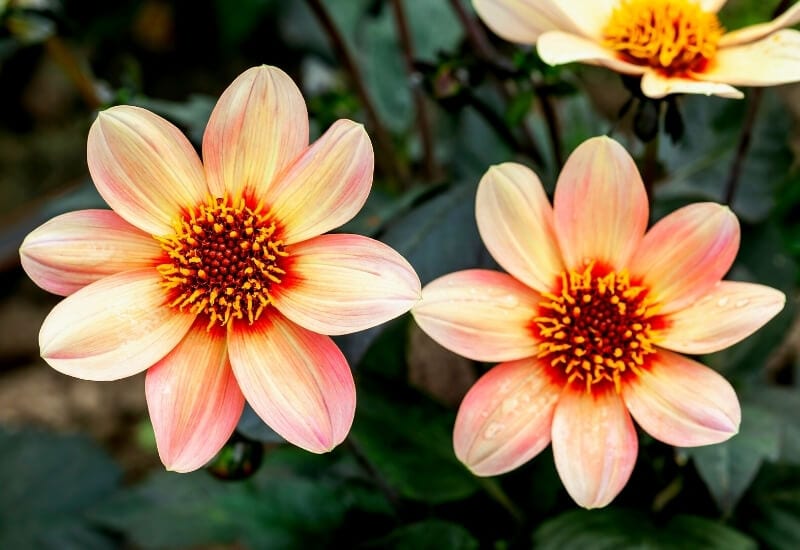
If you thought that single dahlias are less beautiful than double ones you will change your mind when you see single dahlia ‘Sunshine’. To start with, they may be single but they are not small… They can reach 8 inches across (20 cm)! And they are stunning…
The petals are perfectly shaped, regular and evenly arranged. They are broad and rounded and they have beautiful grooves that create beautiful light patterns.
And they are if the most beautiful light and bright yellow but red towards the center. This forms a flaming crown around the disk, which is dark purple and saffron.
And the flowers grow on very dark purple stems, so dark that they look black. This flower, then, is both showy and elegant at the same time, and this may be why it has won the prestigious Award of Garden Merit of the Royal Horticultural Society.
2. Single Dahlia ‘Happy Single Wink’ (Dahlia ‘Happy Single Wink’)
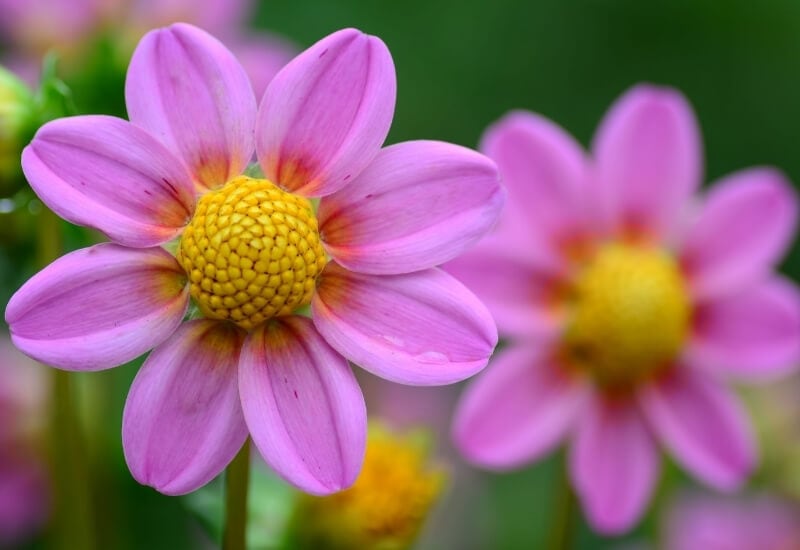
Single Dahlia ‘Happy Single Wink’ has won the Award of Garden Merit by the Royal Horticultural Society, and there must be a reason! Let me tell you…
The petals are round and of a bright and rich magenta shade, but at the center, they turn red purple, forming a crown around the disk, which is framed by a yellow ring of open florets, while the closed ones are purple.
But the purple theme does not end here… The leaves and stems are of a very dark and deep purple shade, almost black. So, the foliage sets of the fairly large (4 inches, or 10 cm) bright flowers very well.
You can imagine what striking contrast these dahlias can bring to your beds, borders or even pots.
Peony And Orchid Dahlias
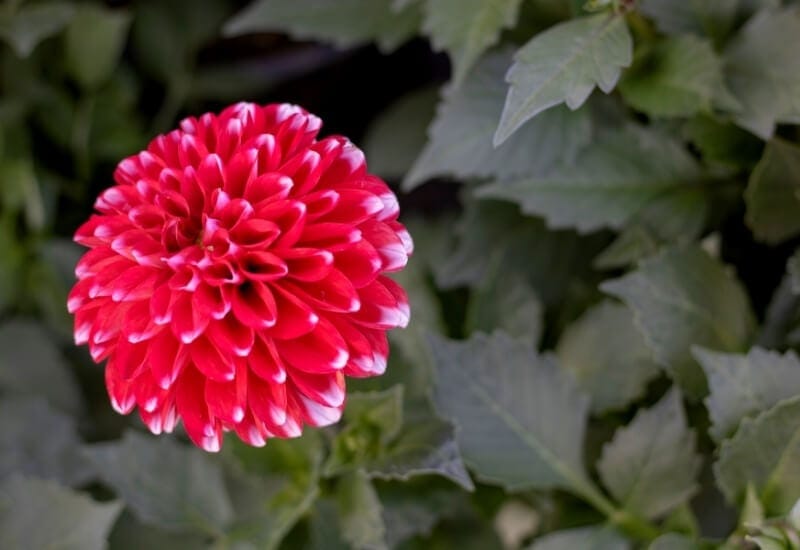
Welcome to the last group of dahlias, those that look like other flowers. They are not exactly the same, don’t get me wrong, but they have a certain similarity. And the flowers they most look like fall into two groups: peonies and orchids.
While these dahlias may be more appealing to collectors, you can understand that having them in your garden can add that unusual and well researched touch to your garden.
They too come in different sizes (of plant and flower) and with all the colors typical of the palette of this amazing flower.
So, let’s see what they can do for you…
1. Peony Dahlia ‘Classic Elise’ (Dahlia ‘Classic Elise’)
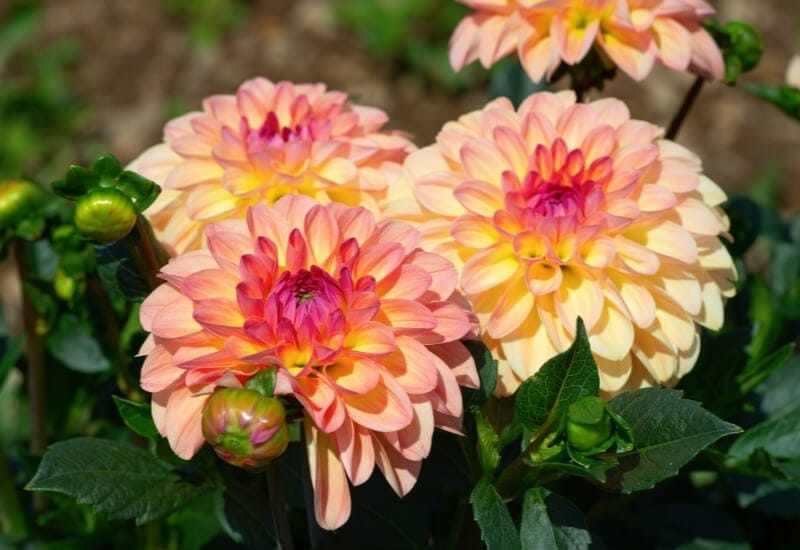
I chose this variety for two reasons: it has the classical peony dahlia shape and it has a very refined but unusual color: peach to coral orange.
What you get with ‘Classic Elise’ is a series of rows of beautiful petals that start flat at the outside and then curl in the inner rows. This forms half a pompon, which still shows the beautiful copper ring inside.
These fairly large flowers (4 inches, or 10 cm) are set against very dark purple foliage and stems. The contrast is both eye catching and very elegant indeed.
This is a flower for a classy and maybe nostalgic flower bed or border, but you can rcereate this effect also in containers on your terrace or patio.
2. Orchid Dahlia ‘Pink Giraffe’ (Dahlia ‘Pink Giraffe’)
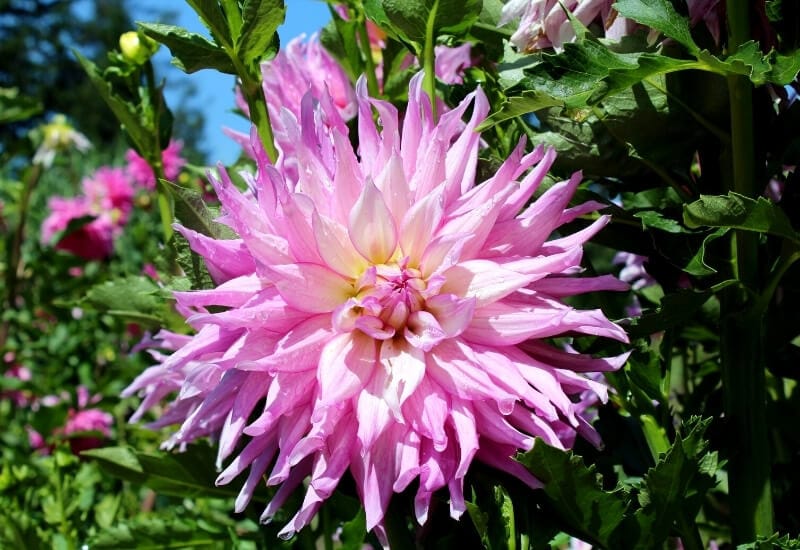
Last but really not least, a striking variety of orchid dahlias that has won the Award of Garden Merit by the Royal Horticultural Society: double orchid dahlia ‘Pink Giraffe’. You would be excused to think it is not actually a dahlia…
The petals of this incredible cultivar grow out from a central point forming a rosette that has a floret at the center.
Each petal curls onto itself lengthways and, as it approaches the tip, it also bends backward. The plasticity and dynamism of this dahlia make it invaluable and very exotic looking.
How about the color? It alternates stripes of deep magenta and white that cut the petals sideways, some lighter, some darker. The effect is unforgettable.
The flowers are fairly large too (6 inches, or 15 cm). So, you will want this eye catching orchid dahlia in your beds, borders or containers only if you need a real protagonist. Or if you w at your window boxes to be seen from a distance!
Waterlily Dahlias
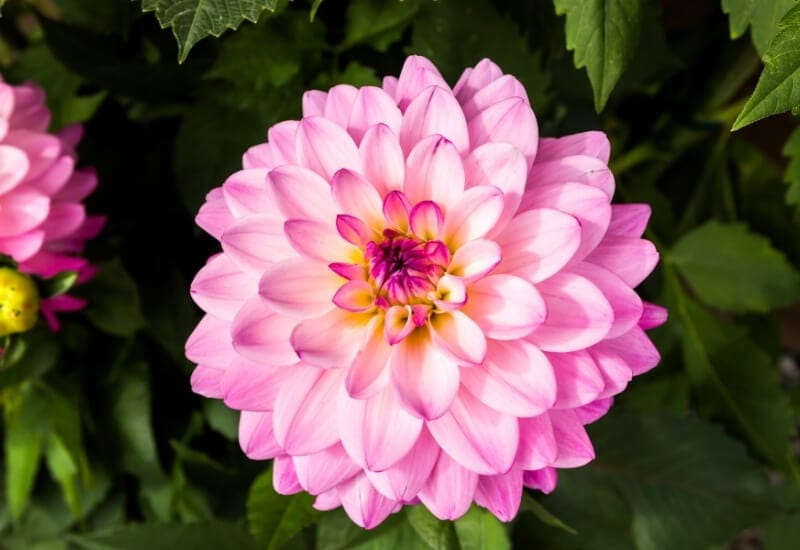
Waterlily dahlias are arguably some of the most beautiful and elegant. They are called so because they may remind you of the famous aquatic flower. This is why they make excellent cut flowers too.
But how can you tell if a dahlia in in the waterlily category? Here is how:
For the rest, they vary a lot in plant size, from 12 inches (30 cm) to over 4 feet (120 cm). The flowers too may range from 2 inches (5 cm) to a whopping foot in diameter (30 cm).
And, as with all dahlias, there is a wide range of colors and color combinations for you to choose from.
And we have chosen two of the most imoressive, just to give you am idea…
1. Waterlily Dahlia ‘Karma Prospero’ (Dahlia ‘Karma Porspero’)
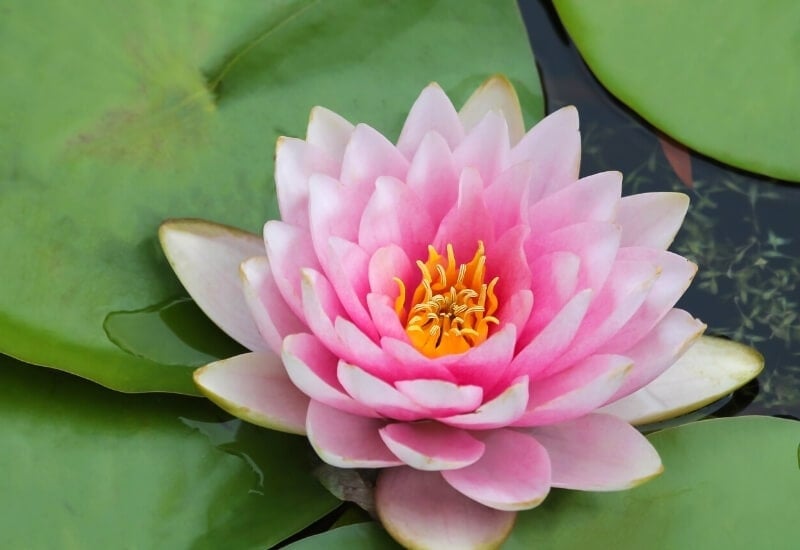
The sheer elegance of waterlily dahlia ‘Karma Prospero’ will blow you away! It really looks like a fantastically colored waterlily indeed…
The petals are white with lilac pink stripes along them, which gives this amazing cultivar a “marble effect”.
They are also beautifully shaped, with broad but well pointed petals (where the lines end) and as they open, they imitate perfectly the cupped shape of waterlilies…
The only difference is that they do not grow on water, but at the top of long and black stems.
This is a fairly large flower variety. Each flower head reaches 6 inches in diameter (15 cm).
The plants are very tall, and this makes it ideal for elegant borders or tall beds. But given its very sculptural look, it is also very suitable to formal gardens.
2. Waterlily Dahlia ‘Karma Chock’ (Dahlia ‘Karma Choc’)
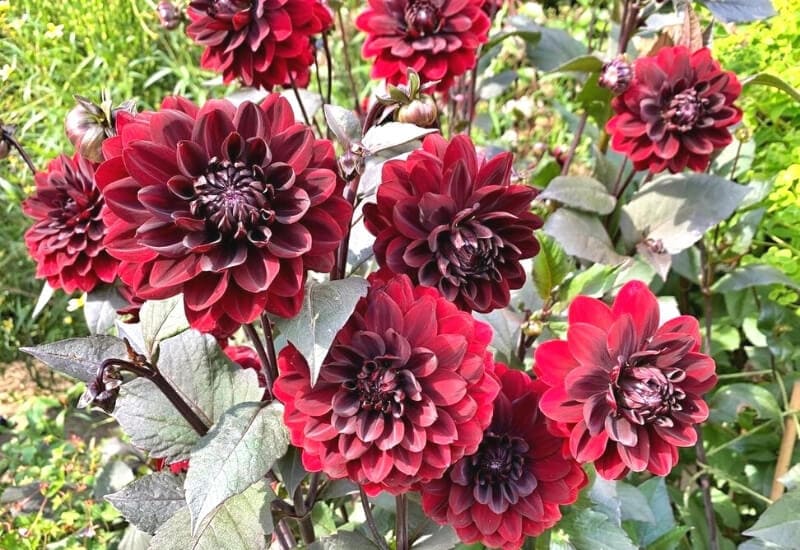
If you want a elegance and great sculptural value, waterlily dahlia ‘Karma Choc’ has no match. It is a dark flower, which already makes it rare but it also makes it stand out…
The flower heads are large (6 inches, or 15 cm) and perfectly shaped.
The petals are perfectly arranged in a rosette with a very smooth and round appearance. What is more, they have a great plastic quality because they are deeply cupped and have a clear tip. each looking like a tiny spoon or tropical leaf.
But I have not told you about the color yet… The outer petals are of a deep, velvety burgundy red shade.
But as you move towards the center of this amazing flower, the petals gradually turn darker, till, in the middle they are of such a dark shade of purple that they look black!
This is a flower you want to have in borders and beds, but also one that could hold its ground as a standalone clump in a decorative pot center stage in your patio or terrace.
The Beautiful World Of Dahlias
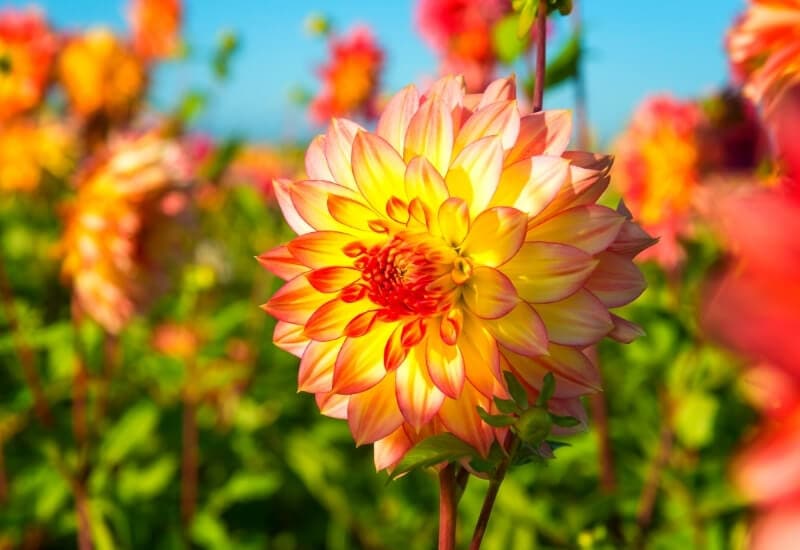
Now you know how to tell the different types of dahlias apart, and you have seen what beautiful varieties there are within this genus of Central American flowers, you must admit that dahlias are some of the most eclectic and lovable flowers ever…
You can have traditional shapes, single flowers, double flowers, pompons, striking shapes, soft shapes, all the colors from white to purple and flowers from very small to literally huge!
But before I leave you one last tip…
You see, dahlias are not cold hardy, but don’t worry. If you live in USDA zones 1 to 7, once the blossom is over, cut down your dahlias to the ground, uproot the tubers and dry them. Put them in cool (not cold) and – above all – dry place and plant them again next spring!

Written By
Amber Noyes
Amber Noyes was born and raised in a suburban California town, San Mateo. She holds a master’s degree in horticulture from the University of California as well as a BS in Biology from the University of San Francisco. With experience working on an organic farm, water conservation research, farmers’ markets, and plant nursery, she understands what makes plants thrive and how we can better understand the connection between microclimate and plant health. When she’s not on the land, Amber loves informing people of new ideas/things related to gardening, especially organic gardening, houseplants, and growing plants in a small space.
